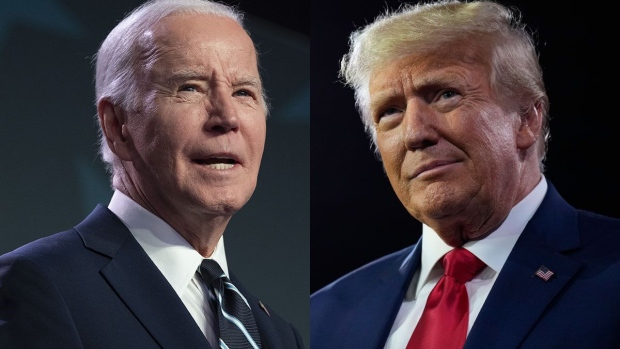Rob Garver
On Thursday, US President Joe Biden and former US President Donald Trump will separately visit the United States’ southern border, highlighting their competing short-term priorities for dealing with what both agree is a serious migration crisis. Biden will travel to Brownsville, a city of 187,000 at the extreme southern tip of Texas and one of the major legal ports of entry for migrants seeking asylum and permission to live and work in the US.
While there, he will meet with federal immigration enforcement officers, law enforcement officials and local leaders. He will likely also call on Congress to pass a bipartisan immigration reform bill negotiated in the Senate, which has been blocked by Republicans. Trump will travel to Eagle Pass, another Texas town a few hundred kilometers north that has been overwhelmed by migrants attempting to cross the border illegally. Many of them also seek asylum and often wind up sheltering in and around the town before they can move farther into the country’s interior to await processing.
Trump is expected to deliver remarks decrying the state of border security and blaming the problem on Biden. Trump may also address the bipartisan immigration proposal drafted by the Senate, which he has criticized and which he has demanded that Republican lawmakers refuse to support. Migration across the southern border has surged sharply in the years following the COVID-19 pandemic. Full-year data for 2023 indicate that Customs and Border Protection officials had more than 2.4 million encounters with migrants on the southern border last year, a record number. CBP also tracks what it refers to as “gotaways” – individuals observed crossing the border by CBP officials or surveillance equipment but who are not apprehended. Since 2021, the agency has identified a minimum of 1.7 million gotaways.
Of the millions who made contact with border officials while crossing, many have requested asylum, triggering a process that requires immigration officials to assess their claims. The current backlog of asylum cases is years long, and large numbers of asylum-seekers are released into the US interior while they wait for their cases to be heard. Public opinion polls indicate that the situation on the border is a serious concern for many Americans. The Pew Research Center recently found that 77% of Americans believe the situation at the border constitutes either a “crisis” or a “major problem.” While that feeling was most prominent among respondents who identified as Republican, at about 90%, it was also true of a majority of those identifying as Democrat, at 66%. In recent months, possibly in response to public concern, Biden has strengthened his rhetoric on the topic, labeling the situation as a “crisis” and demanding new legislation to strengthen his ability to restrict people from entering the US
Many Republicans have argued that the Immigration and Naturalization Act of 1952 authorizes the president to deal with the immigration crisis. Under the law, the president can “suspend the entry of all applicants or any class of applicants as immigrants or nonimmigrants, or impose on the entry of applicants any restrictions he may deem to be appropriate.” However, the Biden administration points out that the more recent Refugee Act of 1980 obligates the president to provide due process to an individual in the US requesting asylum, “regardless of that person’s immigration status or whether the person lawfully entered the country.” For a brief moment a few weeks ago, real progress on the immigration issue appeared possible in Washington. With Democrats desperate to pass a supplemental funding bill to support Ukraine’s fight against Russia, Republicans had indicated that any such bill was a nonstarter unless it was paired with significant immigration reform. In the Senate, a bipartisan group of lawmakers crafted a bill that provided funding for Ukraine. In exchange, Democrats acceded to a number of Republicans’ major requests on border security.
Among other things, it would have made it more difficult for migrants to make asylum claims, greatly increased border agencies’ capacity to detain migrants, and given the president authority to block all border crossings on days when migrant flows rise above specified limits. However, Republican opposition to the deal appeared in January, bolstered by Trump, who criticized the deal on his social media network Truth Social as insufficient, writing, “I do not think we should do a Border Deal, at all, unless we get EVERYTHING needed to shut down the INVASION of Millions & Millions of people, many from parts unknown, into our once great, but soon to be great again, Country!” It quickly became apparent that many in the Republican Party, including Trump, viewed the border as a potent issue in the 2024 elections and were reluctant to pass any legislation that Biden could use to demonstrate that he was taking action on the issue. Republican unwillingness to pass immigration reforms in Congress leaves Biden with few options to demonstrate that he is taking action on the issue, said William A. Galston, a senior fellow in the Brookings Institution’s governance studies program.
“He’s between the proverbial rock and a hard place,” Galston told VOA. “Because if he wants to do something quickly, it will have to be an executive action of some sort, and that limits his options.” Galston added, “Biden’s challenge is to find administrative measures that will move the needle on encounters at the border – and equally important, that will be seen by the American people as moving the needle – without running up against the limits of the existing law.” For example, Biden could issue an executive order making it difficult or impossible for individuals entering the country illegally to claim asylum. However, similar executive actions taken by Trump during his time in office were quickly blocked by federal courts.
Treatment of the border crisis as a political football comes with real human costs, said Greg Chen, senior director of government relations for the American Immigration Lawyers Association. He said the US is now on the receiving end of a historically unprecedented surge in migration across the Western Hemisphere, as millions flee countries where both the economy and the rule of law are collapsing, making the flight north to the US the only viable option for many. “Without improved capacity to process people arriving at the southern border, and also for the broader immigration system, we see major backlogs across the board,” Chen told VOA. “Asylum-seekers and other migrants who are hoping to get legal relief and the opportunity to demonstrate that they should be able to stay in the United States are waiting much longer periods of time.”
Chen said many asylum-seekers trying to enter through legal ports of entry spend days sleeping in lines that extend into areas of Mexico that are racked by violence and often under the control of drug cartels. “The border now needs urgent attention to ensure more efficient and orderly processing of people coming to the US, and so that it can be done in a fair and humane way,” he said.
VOA







